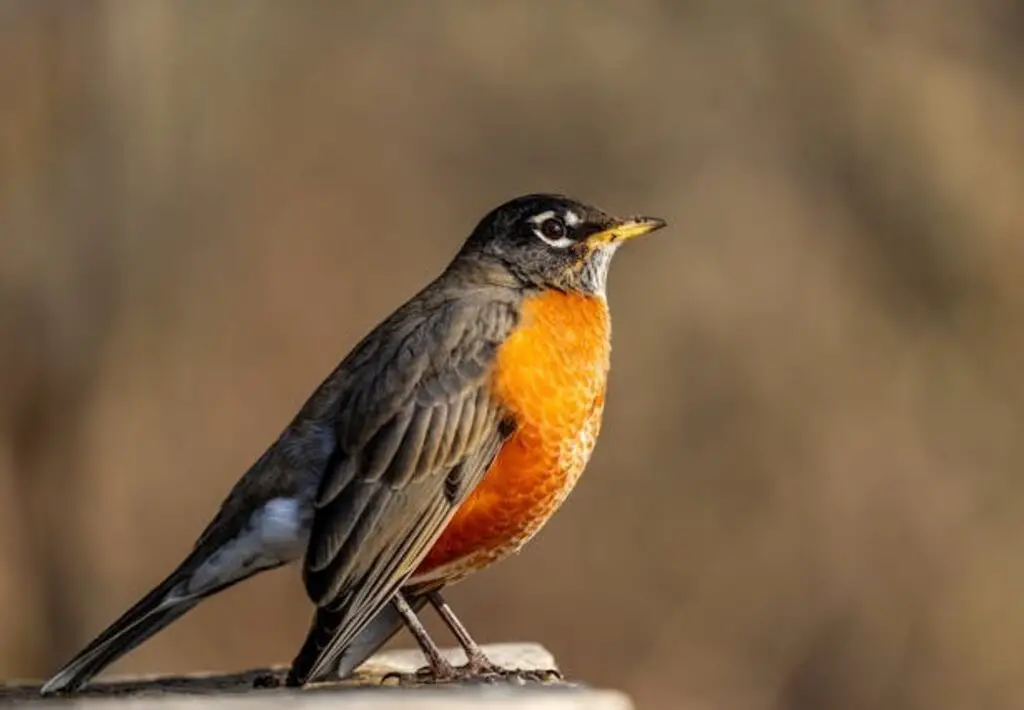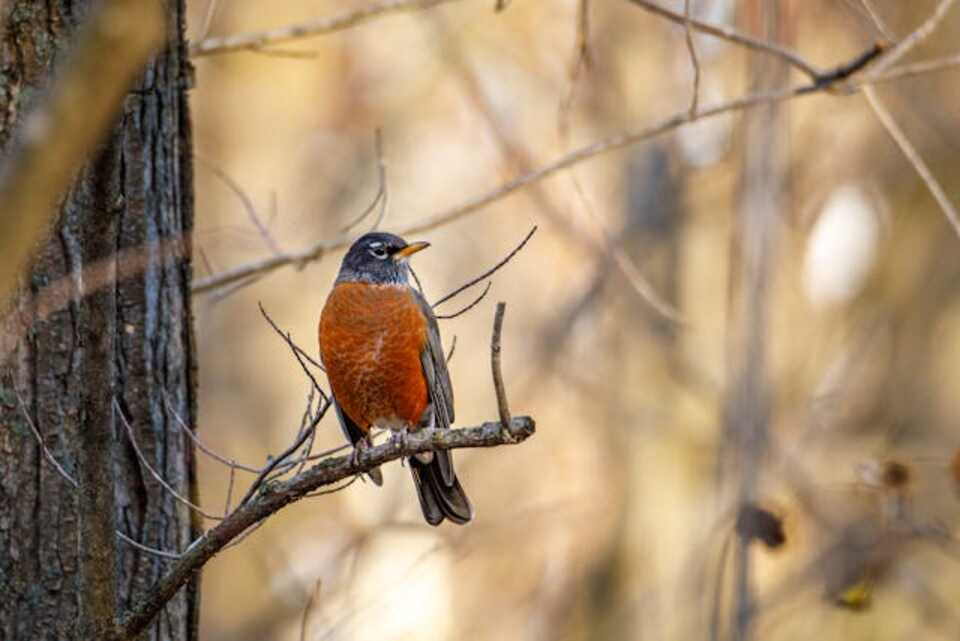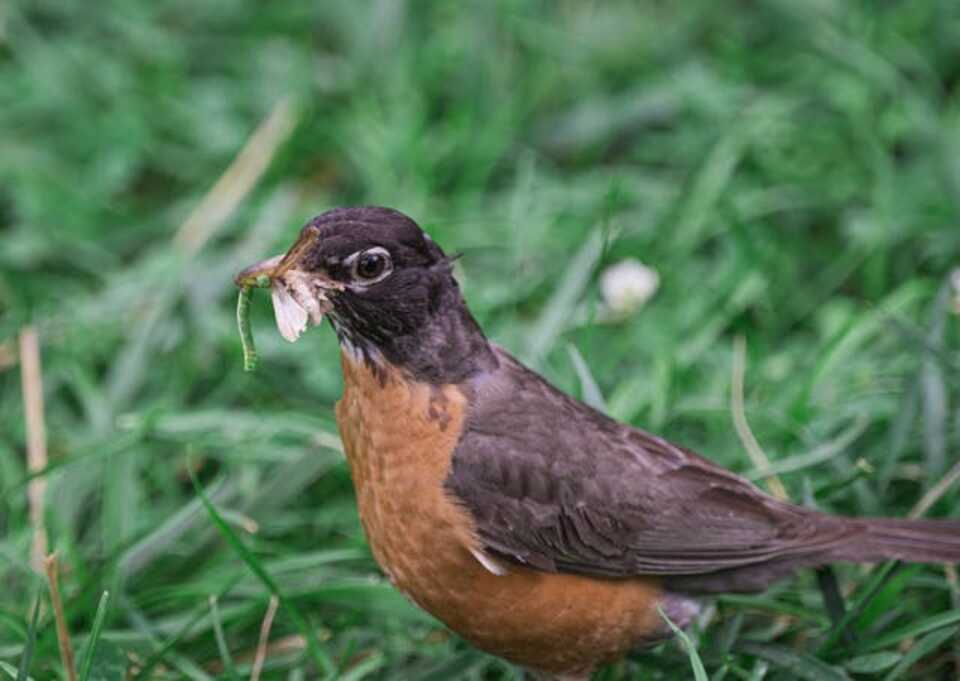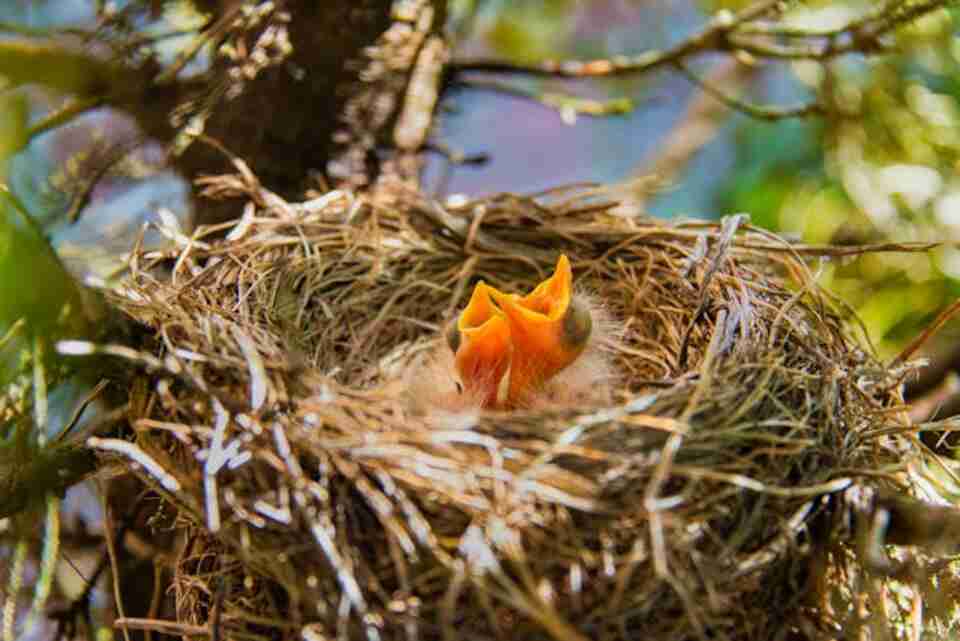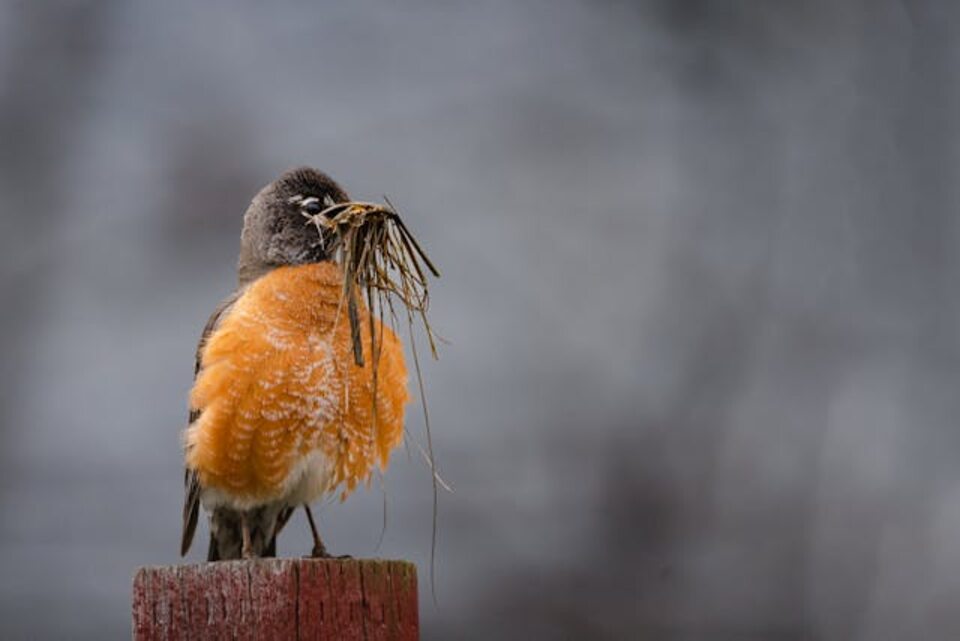Ever spotted a robin hopping across your lawn and wondered what makes it so special? The American robin is one of the most recognizable birds in North America, often signaling the arrival of spring with its cheerful song and vibrant red breast. But what else do we know about this beloved bird? From their unique behaviors to their migratory patterns, there’s so much more to the American robin than meets the eye. Let’s dive into everything you need to know about this iconic species!
Table of Contents
Identifying the American Robin
The Robin’s Unmistakable Appearance
The American Robin (Turdus migratorius) is a sight that brings joy to many. With its bright orange-red breast, dark head, and white eye-rings, it’s hard to mistake this bird for any other species. As the largest thrush in North America, adult robins measure about 25 cm in length and weigh around 77 grams. Their plumage is a striking combination of warm and cool tones, with a rich brown back and wings contrasting beautifully against the vibrant breast.
One of the most captivating features of the American Robin is its expressive eyes. Surrounded by white eye-rings that stand out against the dark head, these eyes seem to convey a sense of curiosity and intelligence. The bird’s bill is yellow with a darker tip, perfectly adapted for its varied diet of insects and fruits.
In flight, robins display a graceful, undulating pattern, their wings creating a mesmerizing rhythm as they move from tree to tree or across open spaces. This distinctive flight pattern, combined with their colorful plumage, makes them easy to spot even for novice birdwatchers.
Distinguishing Male and Female Robins
While both sexes share similar coloration, the males typically sport brighter plumage. This subtle difference has led to many amusing moments in my backyard, as I’ve watched less experienced birdwatchers debate the sex of visiting robins! The males’ breast feathers tend to be a more intense orange-red, while females often have a slightly paler, more muted coloration.
Beyond color, there are other subtle cues that can help differentiate between male and female robins. Males often appear slightly larger and more robust, with a more pronounced swagger in their hop. Females, while still confident in their movements, may seem a touch more delicate in comparison.
During the breeding season, these differences become more pronounced as males engage in territorial displays and courtship behaviors. Their brighter plumage serves as a visual signal of health and fitness to potential mates, while females maintain a more subdued appearance that may help them blend in better while nesting.
The Robin’s Life Cycle: From Egg to Adult
Young robins start life looking quite different from their parents. They hatch with mouse-grey down, which is soon replaced by spotted feathers. By their second autumn, they’ve developed adult plumage, making them indistinguishable from older birds.
The transformation from helpless chick to fully-fledged adult is a remarkable process that occurs over just a few short months. Newly hatched robins are almost featherless, with closed eyes and a distinctive yellow gape that encourages their parents to feed them. Within days, their eyes open, and pin feathers begin to emerge.
As the chicks grow, their juvenile plumage develops, characterized by a speckled breast that provides excellent camouflage. This spotting gradually fades as the bird matures, replaced by the iconic red-orange breast of the adult. The final adult plumage doesn’t fully set in until after the bird’s first winter, marking its transition to sexual maturity.
American Robin Behavior: A Closer Look
Social Dynamics of Robin Flocks
American Robins are highly social creatures, especially during winter. I’ve witnessed firsthand the impressive sight of robins gathering in massive roosts of up to 250,000 individuals. It’s a spectacle that never fails to leave me in awe of nature’s wonders.
These large gatherings serve multiple purposes for the robins. They provide safety in numbers, with many eyes watching for potential predators. The roosts also act as information centers, where birds can share knowledge about food sources and environmental conditions. Younger birds learn from more experienced individuals, picking up essential survival skills.
Within these large flocks, robins form smaller subgroups, often based on age, sex, or familial relationships. These social bonds can persist even as the larger flock moves or disperses. The complex social structure of robin flocks is a testament to their intelligence and adaptability.
Foraging Techniques: The Early Bird Gets the Worm
We’ve all heard the saying, and robins truly embody it. Their characteristic “running and stopping” behavior on lawns is a telltale sign of worm hunting. I’ve spent many early mornings watching robins tilt their heads, listening for the movement of earthworms beneath the soil. It’s a reminder of the incredible adaptations these birds possess.
This hunting technique is more sophisticated than it might appear at first glance. Robins use a combination of visual and auditory cues to locate their prey. Their keen eyesight allows them to spot the slightest movement on the ground, while their ability to hear the subtle sounds of worms moving through the soil gives them an additional advantage.
The American Robin’s Diet: A Seasonal Feast
Seasonal Shifts in Feeding Habits
Robins are opportunistic omnivores, with a diet consisting of both animal and plant matter. About 40% of their diet is made up of invertebrates like earthworms, beetle grubs, and caterpillars. The remaining 60% comes from fruits and berries.
In my observations, I’ve noticed that robins tend to focus more on insects and worms during the breeding season, likely due to the high protein needs of their growing chicks. As autumn approaches, they shift towards a more fruit-heavy diet.
This seasonal shift in diet is a crucial adaptation that allows robins to thrive in a variety of habitats and climates. During spring and summer, when insects are abundant, robins take full advantage of this protein-rich food source. This diet supports the energy demands of breeding and raising young.
As temperatures cool and insect populations decline in fall and winter, robins seamlessly transition to a more fruit-based diet. They become important seed dispersers for many plant species, helping to maintain biodiversity in their ecosystems. This dietary flexibility is one of the key factors in the American Robin’s widespread success across North America.
Attracting Robins to Your Yard: An Expert’s Guide
To attract robins, consider planting native fruit-bearing trees and shrubs. In my garden, serviceberry and huckleberry bushes are particular favorites among the local robin population. Other attractive options include dogwood, holly, and crabapple trees.
Beyond planting, maintaining a healthy lawn can make your yard a robin magnet. Avoid using pesticides, as these can eliminate the insects and worms that robins rely on for food. Instead, focus on natural lawn care methods that promote a diverse and healthy soil ecosystem.
Water is another crucial element in attracting robins. A shallow birdbath or water feature can serve as both a drinking source and a bathing spot. Robins are particularly fond of moving water, so consider adding a small fountain or dripper to your birdbath to make it even more appealing.
Lastly, providing nesting materials can encourage robins to build their homes in your yard. Small twigs, grass clippings, and even strips of bark can be left out for robins to incorporate into their nests. This not only attracts them but also gives you a front-row seat to the fascinating process of nest building and chick-rearing.
Nesting and Reproduction: The Robin’s Life
The Art of Nest Building
Watching a robin construct its nest is a true marvel. These skilled architects use mud, grass, and other materials to create a sturdy cup-shaped structure. I once observed a female robin spend nearly three days perfecting her nest, meticulously weaving each blade of grass into place.
The process begins with the female selecting an appropriate site, often in the fork of a tree branch or on a sturdy human-made structure like a porch light or window ledge. She starts by creating a base of twigs and grass, then builds up the walls of the nest using mud as a binding agent. The interior is lined with soft grasses and other fine materials to create a cozy environment for the eggs and chicks.
What’s particularly impressive is the robin’s ability to adapt its nest-building techniques to different environments. In urban areas, I’ve seen robins incorporate unusual materials like string, paper, or even plastic into their nests, demonstrating their resourcefulness and adaptability.
The Breeding Cycle: From Egg to Fledgling
Robins typically attempt to raise 1-3 broods per breeding season. This ambitious reproductive strategy means that robin parents are busy from early spring well into summer. I’ve watched many robin couples work tirelessly to feed their hungry chicks, making countless trips back and forth with beakfuls of worms and insects.
The female usually lays 3-5 bright blue eggs, which she incubates for about two weeks. During this time, the male takes on the role of protector and provider, bringing food to his mate and defending the territory from potential threats.
Once the chicks hatch, both parents are kept busy with near-constant feeding duties. Young robins grow rapidly, and within just two weeks, they’re ready to leave the nest. This fledging period is a critical and dangerous time for young robins, as they learn to fly and forage while avoiding predators.
It’s not uncommon for robin parents to start preparing for their next brood even as they’re still caring for fledglings from the previous one. This overlap in broods showcases the incredible stamina and dedication of these hardworking birds.
Conservation and Coexisting with Robins
Adapting to Human Environments
One of the most remarkable things about American Robins is their ability to thrive in human-altered landscapes. From suburban lawns to city parks, these adaptable birds have found ways to coexist with us.
Robins have shown an impressive ability to utilize human structures for nesting and foraging. They readily build nests on buildings, in hanging planters, or even in abandoned vehicles. Their comfort around humans has made them one of the most familiar and beloved bird species in North America.
This adaptability extends to their foraging habits as well. Robins have learned to take advantage of human-created food sources, such as fruit trees in orchards or earthworms in well-watered lawns. They’ve even been observed following lawn mowers to catch insects disturbed by the machine.
However, this close association with humans also brings challenges. Robins face numerous threats in urban and suburban environments, including collisions with windows, predation by domestic cats, and exposure to pesticides and other pollutants.
Creating Robin-Friendly Spaces: A Call to Action
Despite their adaptability, robins face numerous challenges. Window collisions, predation by domestic cats, and pesticide use all pose significant threats. As responsible nature lovers, we can take steps to mitigate these risks.
To help robins thrive, consider these actions:
- Avoid using pesticides on your lawn
- Install bird-friendly window treatments to prevent collisions
- Keep cats indoors or supervised when outside
- Provide a clean birdbath for drinking and bathing
Beyond these basic steps, there are many ways to create a truly robin-friendly environment. Planting native species that provide food and shelter for robins is a great start. Consider creating a “robin garden” with a mix of fruiting shrubs, trees that support caterpillars (a favorite food for robin chicks), and open grassy areas for worm hunting.
Leaving some areas of your yard a bit “messy” can also benefit robins. A pile of leaves or a section of unmowed grass can harbor insects and provide nesting materials. If you have dead trees that don’t pose a safety risk, consider leaving them standing as they can provide excellent nesting sites for robins and other cavity-nesting birds.
Ecological Role of Robins
Robins as Seed Dispersers and Insect Controllers
Robins play crucial roles in their ecosystems. By eating fruits and berries, they help disperse seeds across the landscape. Their insectivorous habits also help control pest populations, benefiting both natural areas and human agriculture.
The seed dispersal role of robins is particularly important for maintaining and regenerating forests and other plant communities. As robins consume fruits, the seeds pass through their digestive system and are deposited in new locations, often far from the parent plant. This process helps plants colonize new areas and maintains genetic diversity within plant populations.
In terms of insect control, robins consume a wide variety of pest species that can damage crops and gardens. Their preference for earthworms also helps aerate and mix soil layers, improving soil health. This natural pest control and soil improvement service provided by robins is a significant benefit to both ecosystems and human agriculture.
Robins as Indicators of Environmental Health
As common and widespread birds, changes in robin populations can serve as early warnings of broader environmental issues. This makes them valuable subjects for citizen science projects and ecological research.
Robins are particularly sensitive to changes in temperature and precipitation patterns, making them excellent indicators of climate change impacts. Their migration timing and breeding success can provide valuable data on how ecosystems are responding to shifting environmental conditions.
Additionally, because robins are found in a wide variety of habitats, from pristine forests to urban centers, they can provide insights into the health of different ecosystem types. Monitoring robin populations and behavior across these diverse environments helps scientists understand the complex ways in which human activities are affecting wildlife and natural systems.
Citizen science projects focused on robins, such as the Journey North program, engage thousands of volunteers in collecting data on robin migrations and behaviors. This wealth of information not only contributes to scientific understanding but also helps foster a connection between people and the natural world around them.
American Robin Facts at a Glance
| Characteristic | Description |
|---|---|
| Scientific Name | Turdus migratorius |
| Average Length | 25 cm (9.8 inches) |
| Average Weight | 77 grams (2.7 ounces) |
| Wingspan | 31-40 cm (12-16 inches) |
| Lifespan | 2 years (wild), up to 14 years (captivity) |
| Breeding Season | April to July |
| Clutch Size | 3-5 eggs |
| Incubation Period | 12-14 days |
| Fledging Period | 14-16 days |
| Diet | Omnivorous (worms, insects, fruits) |
| Habitat | Woodlands, suburbs, urban areas |
| Range | Throughout North America |
| Conservation Status | Least Concern (IUCN Red List) |
From its cheerful song heralding the arrival of spring to its industrious foraging on our lawns, the American Robin has firmly established itself in the hearts of nature lovers across North America. My own experiences watching and studying these birds have deepened my appreciation for the natural world and the intricate connections that sustain it.
As we continue to share our environments with American Robins, let’s strive to be good neighbors. By creating bird-friendly spaces and being mindful of our impact on their habitats, we can ensure that future generations will also have the joy of watching robins hop across their lawns on crisp spring mornings.
Remember, every time you spot a robin, you’re witnessing a small but significant part of the great web of life that surrounds us. So next time you see that flash of red-orange outside your window, take a moment to appreciate the remarkable bird that is the American Robin.

